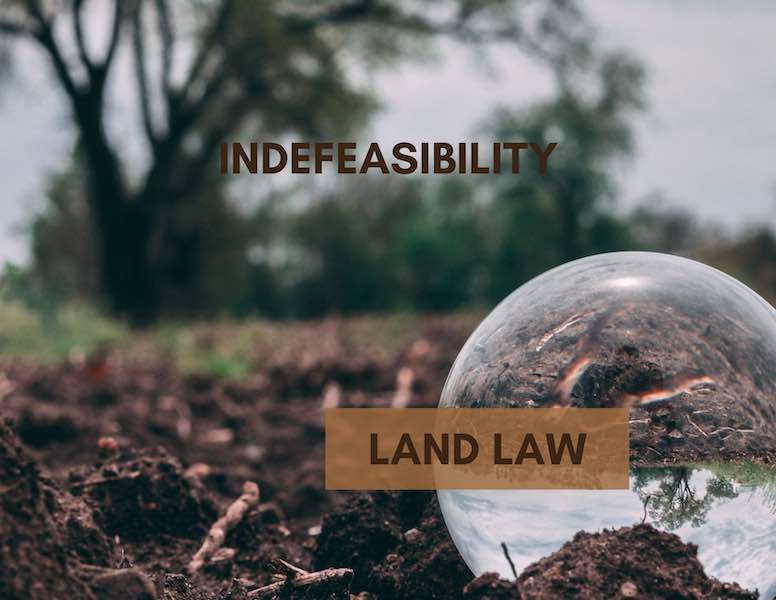See Leong Chye v United Overseas Bank – On Indefeasibility and Implied Terms
by Sean Tan Yang Wei and Asiah Siddiqah ~ 5 July 2021
In See Leong Chye v United Overseas Bank [2019] 1 MLJ 25, two appeals were heard together before the Federal Court. In the first appeal, the Court was asked to revisit its decision on the indefeasibility of title or interest in land under s.340 National Land Code which provides that:
(2) The title or interest of any such person or body shall not be indefeasible –
(a) in any case of fraud or misrepresentation to which the person or body, or any agent of the person or body, was a party or privy; or
(b) where registration was obtained by forgery, or by means of an insufficient or void instrument; or
(c) where the title or interest was unlawfully acquired by the person or body in the purported exercise of any power or authority conferred by any written law.
(3) Where the title or interest of any person or body is defeasible by reason of any of the circumstances specified in subsection (2)—
(a) it shall be liable to be set aside in the hands of any person or body to whom it may subsequently be transferred; and
(b) any interest subsequently granted thereout shall be liable to be set aside in the hands of any person or body in whom it is for the time being vested:
Provided that nothing in this subsection shall affect any title or interest acquired by any purchaser in good faith and for valuable consideration, or by any person or body claiming through or under such a purchaser.
The second appeal concerned implied terms in contractual disputes.
Brief Facts
The case revolved around a piece of land owned by the Appellant and his brother (the “See Brothers”) in equal shares. The land was fraudulently transferred to a bona fide purchaser, Heveaplast, by individuals masquerading as the See Brothers (“SPA 1”). Heveaplast obtained a loan from UOB to part-finance the purchase and charges were created by Heveaplast in favour of UOB. Pending the completion of SPA 1, Heveaplast entered into another sale and purchase agreement to sell the land to another purchaser, Kum Hoi (“SPA 2”). Kum Hoi went on to obtain a loan from PBB to part-finance the purchase on the security of a charge over the land to be created by Kum Hoi. As part of the transaction of SPA 2, Heveaplast gave an undertaking to PBB to refund the monies if the land could not be transferred to Kum Hoi, whilst UOB made a similar undertaking to PBB to refund the monies in the even that UOB’s charges could not be discharged (“the UOB Undertaking”).
Seven months later, the See Brothers lodged police reports after they discovered that their land was transferred to Heveaplast. A Registrar’s Caveat was entered on the title of the land which resulted in the transfer of the land to Kum Hoi, the discharge of the charge in favour of UOB, and thus, the charge in favour of PBB could not be registered. The See Brothers filed a suit in the High Court and successfully set aside the registered title and interest of Heveaplast and UOB. The High Court also allowed Kum Hoi’s claim for a refund against UOB and Heveaplast.
At the Court of Appeal, UOB’s appeal against the See Brothers was allowed and it was held that UOB’s interest in the land was indefeasible under s.340 of the NLC as UOB was in fact a subsequent purchaser for good consideration. Consequently, the Court of Appeal set aside the order cancelling UOB's charges over the land. Meanwhile, UOB’s appeal against the Kum Hoi refund was also dismissed. Dissatisfied about the respective decisions, both the See Brothers and UOB appealed to the Federal Court.
Indefeasibility of Title or Interest in Land – Immediate vs Subsequent Purchaser
In considering the See Brothers’ appeal, the Apex Court reaffirmed the position in Tan Ying Hong v Tan Sian San & Ors [2010] 2 MLJ 1. In essence, the Federal Court confirmed the principle that s.340 NLC conferred deferred indefeasibility and not immediate indefeasibility on title or interest in land. The question of whether a title or interest in land is indefeasible is a question of mixed fact and law. The answer to this question depends on whether the purchaser is an immediate or subsequent purchaser.
If the purchaser is an immediate purchaser, s.340(2) of the NLC will apply. Accordingly, the immediate purchaser’s title or interest is defeasible and may be set aside by the rightful owner of the land if it was obtained through any one of the vitiating factors listed under s.340(2) of the NLC (i.e., fraud, misrepresentation, forgery, insufficient or void instrument). However, if the facts show that the purchaser is a subsequent purchaser in good faith for valuable consideration, then his title or interest is indefeasible under the proviso to s.340(3) of the NLC.
Thus, in See Leong Chye, the Federal Court held that Heveaplast was considered the immediate purchaser when it was registered as the owner of the land pursuant to the fraudulent transfer. The Federal Court also agreed with the Court of Appeal that UOB’s interest in the land was derived as a chargee of the Land only after the memorandum of transfer from the See Brothers to Heveaplast was lodged. Although the transfer of the land to the purchaser and the registration of the charges were effected on the same day, these two interests would be registered one after another (a two-step transaction) and not as a single transaction. As such, the proviso to s.340(3) of the NLC would apply to UOB as it would be a subsequent purchaser, having acquired the interest to the land from the immediate purchaser in good faith for valuable consideration.
Implied terms in contractual disputes
UOB’s Appeal to the Federal Court was also founded on the complaint that the Court of Appeal wrongly inferred the existence of an implied term in a contractual dispute, where implied terms were not in issue.
In considering this issue, the Federal Court affirmed that the test for determining whether a term ought to be implied is the officious bystander test and the business efficacy test. As explained in the Federal Court decision of Sababumi (Sandakan) v Datuk Yap Pak Leong [1998] 3 MLJ 151, the officious bystander test is a subjective test which requires the implied term to be something so obvious that “it goes without saying”. Meanwhile, the business efficacy test is used to determine whether the implied term would give the desired result of the contract between the parties.
In See Leong Chye, the Federal Court agreed in entirety with the Court of Appeal’s decision that the UOB Undertaking, the loan agreement and SPA 2 were inextricably linked and formed part of the same transaction. Applying the two tests as described in the Sababumi decision, the Court of Appeal was correct in finding that it “goes without saying” that the obligation of PBB to lend is conditional on the Heveaplast’s ability to transfer the land to Kum Hoi. Such an implied term would give business efficacy for the simple reason that any loan extended by a financial institution is solely on the ground that the borrower has good title to the land and therefore is able to provide good security for the loan.

